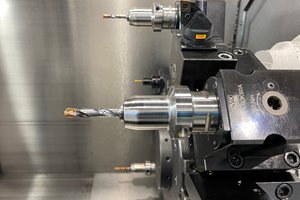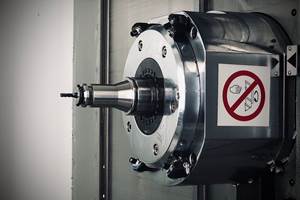Inside the Process of Cutting Tool Recycling
Global Tungsten & Powders, part of the Ceratizit Group, sheds light on the processing steps that convert a shop’s used inserts into new tools and other applications.
Share








Autodesk, Inc.
Featured Content
View More.png;maxWidth=45)
DMG MORI - Cincinnati
Featured Content
View MoreGlobal Tungsten & Powders Corp. operates multiple tungsten carbide recycling centers in Europe, and a U.S. site in Towanda, Pennsylvania (pictured). This site processes end of life cutting tools and other tungsten-containing scrap and reverts it into raw materials that can be reused to make new parts with the same properties as those made with mined tungsten ore. U.S. based machine shops using tools from Ceratizit are likely using materials processed at this plant. Source, all images: Ceratizit / GTP
Conversations about and efforts toward sustainability and circularity are becoming increasingly common among manufacturers in a variety of industries.
In the machining space, one sustainability topic is so common it’s rarely talked about: Recycling of used cutting tools at their end of life.
This is a practice that is done routinely in many regions, but where does the material actually end up, and what should shops know about this process and its overall sustainability impact?
Global Tungsten & Powers (GTP) is one company working in this area. GTP, owned by the Plansee Group, specializes in the manufacture of tungsten carbide and related products, made from either primary mined tungsten or secondary recycled materials. The company operates production facilities in Finland, Luxembourg, and Towanda, Pennsylvania in the U.S.
At the Towanda site, much of the tungsten carbide powder and related powder materials produced are used to manufacture new cutting tools, which are reported to comprise, on average, about 90% tungsten carbide.
The tungsten comes from a mix of mined or recycled sources, but Jonathan Schaefer, managing director at GTP Powders, explains that while the Towanda site has had recycling capabilities for many years, recycling has become a much greater focus for since the Plansee Group acquired the company in 2008.
In fact, he says that today, the overall Plansee Group sources about 75% of its tungsten from secondary sources — “and that’s between all of its facilities. In the U.S., we are using even slightly more than that.”
The materials that GTP Powders produces can then be sent to cutting tool manufacturer Ceratizit, which is also part of the Plansee Group, for manufacture into cutting tools or tungsten carbide rods, or to manufacture parts containing tungsten for a variety of other industries.
Why is this important for the machining industry?
As Schaefer explains, the “sustainability” conversation within the overall manufacturing industry has impacted regions such as Europe more quickly than in others like North America, but that it is of increasing importance.
He says, “When the recycling of tungsten was first set up in Towanda, the driving force wasn’t so much sustainability as cost savings on raw materials. Over time, the environmental footprint, circularity, and keeping a more localized manufacturing footprint, have all become greater parts of the conversation.”
Angie Roxas, Ceratizit’s head of regional marketing for the Americas, agrees. “There is a big circularity issue, and it’s not talked about enough in the U.S. yet. Tungsten, like many materials we use in this industry, is not an infinite natural resource. So as a company, we need to be conscientious and careful with these natural resources, reusing as much as possible.”
Ceratizit and GTP aim to lead the conversation around sustainability in machining in North America, including operations such as GTP’s Towanda plant.
She emphasizes that “recycled” can sometimes be interpreted as “of inferior quality” — but that’s not the case with tungsten carbide cutting tools. “With these, you can easily separate out the cobalt or the coating or any other binding materials, and then it’s just pure tungsten that goes through the system and gets remade into new tools.”
According to Schaefer, the process for manufacturing tungsten carbide from either primary mined tungsten or secondary recycled material “is very similar. There are a few differences in the beginning of the process, but once you get to the chemical processing, you’re breaking it down to the individual atoms” that then get processed from there.
Roxas adds, “The reality is that today, every cutting tool that’s used likely has some recycled elements to it.” According to its July 2024 sustainability report, Ceratizit achieved a tungsten recycling rate of 95% in 2023.
That being the case, how does the process work?
How It Works: Recycling Tungsten Carbide
GTP works with scrap dealers to collect used carbide from cutting tools and other tungsten-containing end of life products, or shops can send used inserts and tools back to GTP directly.
Schaefer notes, “Cutting tools do usually find their way back into the loop. The good thing about tungsten is that it’s valuable, so the scrap gets customers a decent price.”
On arrival, all scrap gets sorted by GTP and categorized. Scrap can generally be grouped as hard or soft — “hard scrap meaning used inserts or drill bits, for example, and soft scrap meaning something like grinding sludge or powders,” Schaefer explains.
GTP works with scrap dealers to collect end of life parts from shops and other companies, or shops can send used scrap back to the Towanda site directly to be sorted and reprocessed.
After sorting, all scrap goes through an analysis process in GTP’s lab, where technicians assess the tungsten content and determine any additional impurities or elements that may be present. “Everything is analyzed to make sure it’s safe for us to work with, first, and then to make sure it’s within the limits of what we can process,” Schaefer says.
Next, the material is sent through one of GTP’s several recycling processes appropriate to the type of material, as well as the shape it’s in.
In a typical recycling path, the secondary raw material goes through a multi-step chemical and thermal process. First, it goes through a series of chemical processes to convert it to intermediate product ammonium paratungstate (APT). Next, it is converted to tungsten oxide powder, which involves heat treatment in one of several gaseous atmospheres — nitrogen, air, etc. “There’s some downstream demand for the powder itself, but mostly we take the powder and refine it through successive processes to make tungsten metal or tungsten carbide powders, and we can take that a step further to make ready to press powder, or RPT,” Schaefer says.
He explains further, “There are different reactions that occur at different temperatures and in different atmospheres. If you put the material in an atmosphere with oxygen, such as air, it will convert into a metal oxide, for example. If you want to then convert into a metallic tungsten, you put it in a hydrogen atmosphere. If you want to obtain a tungsten carbide powder, you mix tungsten metal powder with carbon and then go through a heat treatment where the carbon diffuses into the tungsten and forms a tungsten carbide. I’d call all of these powder processes, with individual atmospheres and temperature regimes in order to get a certain chemical configuration, grain size and composition.”
The end result? Ready to use tungsten carbide powder that can be reprocessed by Ceratizit or by other customers for a variety of applications.
The resulting tungsten carbide powder or RTP can then be used for a typical cutting tool manufacturing process. “What a lot of people don’t realize is that mined tungsten ore also goes through a lot of refining before it is usable for manufacturing as well,” Schaefer says. “It usually comes out of the mine quite diluted, and there are a lot of processing steps needed until it is in a similar concentrated form that you can start with.”
A portion of the material GTP produces through this process goes back to Ceratizit for manufacturing cutting tools, while some is reverted into a variety of other applications. Ceratizit then uses the tungsten carbide powder to produce rods or inserts for its customers.
“Sustainability” Doesn’t Stop at Recycling
Schaefer says, “We encourage everybody in all industries to find a way to give the materials back — it doesn’t have to be back to us, necessarily, but it’s important that it’s returned and reused. I’d say the cutting tool industry is doing a fairly good job in returning it.”
One reason for this is that the designs of most cutting tools typically is easily separated pieces — a metal carbide fixture on top of a steel body. Cutting tools at their end of life are also generally in relatively good condition, with the cutting edge simply worn down. “90-95% of the tool is still intact,” he says. “That’s opposed to other operations like grinding or milling, where the tool is often worn down to almost nothing at the end.”
Schaefer points out that just because GTP’s main business is recycling, doesn’t mean that it doesn’t have work to do to improve its own internal sustainability within its operations.
“Sustainability” for any business doesn’t stop with recycling scrap or using recycled materials. “At GTP, we’re working on energy reduction, and switching to renewable energy sources, and are always looking for new ways to recycle the chemicals and gases used in our processes,” he says.
Related Content
High-Feed Machining Dominates Cutting Tool Event
At its New Product Rollout, Ingersoll showcased a number of options for high-feed machining, demonstrating the strategy’s growing footprint in the industry.
Read MoreForm Tapping Improves Tool Life, Costs
Moving from cut tapping to form tapping for a notable application cut tooling costs at Siemens Energy and increased tool life a hundredfold.
Read MoreCustom PCD Tools Extend Shop’s Tool Life Upward of Ten Times
Adopting PCD tooling has extended FT Precision’s tool life from days to months — and the test drill is still going strong.
Read MoreHow to Troubleshoot Issues With Tool Life
Diagnosing when a tool is failing is important because it sets an expectation and a benchmark for improvements. Finding out why gives us a clue for how to fix it.
Read MoreRead Next
Ready for Life Cycle Assessment?
Tier suppliers are increasingly being asked to report data related to carbon footprint and environmental impact. The requirements are likely to spread through the supply chain. Here is an introduction to life cycle assessment (LCA).
Read MoreSustainability at IMTS and Beyond
As sustainability becomes more critical for domestic manufacturing, European and Asian companies are bringing this politicized topic to the American market.
Read MoreBuilding Out a Foundation for Student Machinists
Autodesk and Haas have teamed up to produce an introductory course for students that covers the basics of CAD, CAM and CNC while providing them with a portfolio part.
Read More
.jpg;width=70;height=70;mode=crop)


















.png;maxWidth=150)













.jpg)














